I’ve saved this one up for a while. For those of you who remember when Minesweeper was distributed — for free?? — with every copy of Microsoft Windows. What are the odds that unlikely layouts, like 8s, or neighboring 7s, are possible in that game? Alternatively, is it possible to get a game that can be completed in one move? Find out here (16 minutes):
Tag: niche
Spelunky 64
The thing about Spelunky 64, a reimplementation of Spelunky on the Commodore 64, that gets me is how smooth the scrolling is. Smooth multi-directional scrolling isn’t easy to do on the C64 without hardware assistance, but here it handles it without apparent problem. Here is a 7-minute demonstration from Just Jamie:
It’s not the only obstacle Paul Koller (PaulKo64) had in making this surprisingly faithful recreation. It contents itself with the basic Atari-style joystick, with a single overloaded button. So up is used for jumping, tapping the button attacks, holding the button uses an item, down+button takes out a bomb, and up+button places a rope. It’s not perfect, and you have to be really careful in shops, but it doesn’t work badly.
BastichB 64K has an interview with its developer on Youtube (7 1/2 minutes):
Here is a complete playthrough (28 minutes):
Spelunky 64 is on itch.io for $3. To play it, you’ll need a Commodore 64 emulator, or a physical C64 and a way to get the game image onto a disk.
Banjo-Kazooie Decompiled
Kaze Emanuar on Youtube passes along the info that Rare’s terrific N64 platformer, Banjo-Kazooie, has been decompiled (7 minutes):
What does that mean? It’s that they’ve created source code (up on GitLab) that, when put through the same C compiler that originally generated Banjo-Kazooie’s object code, produces an exact binary image of the game. They can now rebuild Banjo-Kazooie. They don’t know the original variable names or any comments that were in the code, so it doesn’t mean that the code is perfectly understandable, but it is a major breakthrough in using the game engine for other things, including game improvements, mods, repurposings, and even compiling it for other platforms.
One result of this is that we now have a complete list of the codes that can be entered into the infamous Sandcastle Room, which are obfuscated in the original binary. The Sandcastle Room is a board of letters on the ground in the second level that can be used to spell things out, and if the proper text is entered it can unlock things in the game, or even enable the items in the abandoned “STOP N SWOP” feature that had been planned to allow players to transfer data between cartridges. If you decide to take a look yourself, the codes are listed out in the file named code_3E30.c.
Arcade Mermaid: Rampart, Part 4: Level Strategy
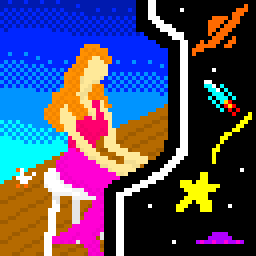
Arcade Mermaid is our classic arcade weirdness and obscurity column! Frequently (no promises) we aim to bring you an interesting and odd arcade game to wonder at.
Yes! More Rampart! I’m still out of town at DragonCon so I’m repurposing an old strategy guide I wrote for Extended Play into a week of posts. Even I’m starting to get sick of Rampart by now, but please stick around. And if you’ve ever tried playing this infuriating game in the arcade, this might give you the advice you need to get through to levels you might not have thought possible! And this is even a fairly short post!
Level Strategies
Level One (“Recruit”)

Castles available: 6
It’s advised not to start on this level unless it’s your first game. You’ll not only miss out of 5,000 points by starting here, but it means the beginning of Level 2 will begin you with only two cannons instead of three, and you’ll face more ships.
This level is so easy that it barely rates mention. It has six castles, and only Gunships appear. Unless you’re purposely stalling, you’ll finish this map in two rounds. Even if you stall, the level auto-completes in three rounds, regardless of if you fire a single shot.
Another reason to avoid picking Beginner is that its selection is always the “J” map, which is one of the easier selections from the initial four boards. It’s better if you pick it later, when the opposition is harder, to balance out the difficulty.
Level Two (“Veteran”)
Castles available: 5
The Veteran level is randomly chosen from one of the other three basic maps, although it tends to be the “C” map most often. Ideally it won’t be the “Hat” map, it being the easiest, as you’ll want it to be your Level 4.
If you started on the board, the first round will always put you up against four ships, one of which may be a Lander. Later ships are frequently also Landers. As a result grunts may appear on this board, but even if some appear, so long as you focus on destroying enemy ships and don’t suffer major setbacks like losing your home castle, you’ll probably wipe out the attackers before they become a huge problem.
On a later round in this level you’ll probably encounter your first Red Ship. A Red Ship tends to get off two or three shots in a round, each producing flaming crater you must build around.
Level Three
Castles available: 5
You always get to pick this level yourself. I usually try to make it “C,” “J” or “Hat,” in that order. I usually avoid picking “N,” but it’s not really harder than “C,” so pick whatever is your preference.
Much of the fleet will be Landers here, so this is the first level where you must be diligent about thinning out their numbers. Especially try to take care of ships about to land; grunts are unwelcome visitors to deal with, and it’s best if they never show up at all. In the event of a landin, which is sometimes unavoidable, try to spare a few seconds to build a barrier to them, to wall them off from the rest of the board. If you can contain them in a small area around the landing, you can keep their numbers down that way and thus reduce the number of shots you must expend in cleaning them up. Don’t think you can just let them be! They will overwhelm you easily if you ignore them.
I try to pick a home castle that’s near another castle, so I can capture them both with one wall. If you can consistently get both each round, that’s three cannons each time. Use them to connect the space between the two castles, but try to keep that space as small as possible. Try to aim for the minimum-sized rectangle needed to save both of them, and then try to place all your cannons within that rectangle.
Level Four
Castles available: 4

Now the game starts to get serious. If you can get here on your first credit you’ve done very well, but your weak basic guns will become more and more of a liability for you. Dark ships start appearing on this level, and will continue to appear until the end of the game. They all take one extra hit to sink. That’s three hits for Gunships, four for Landers, and six for Red Ships.
Try to make Landers that have a chance of landing at a diagonal shore your top priority. If one makes it through, then at the start of the Building phase devote three seconds or so it blocking their progress with walls. If they get away from the shore and a significant number appear, then focus on surviving and shoot them with cannons during Battle. Red Ships start to be a significant threat here. Once all the potential landings are taken care of, try to pump six shots into a Red Ship.
Level Five (peninsula)
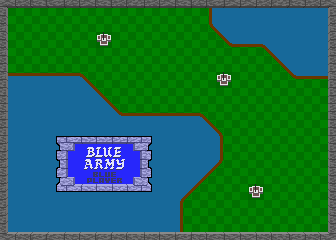
Castles available: 3
Regardless of how you got here, you have a choice between two new maps for this level, a diagonal peninsula going upper-right to lower-left, or one going from upper-left to lower-right. I call these the “slash” and “backslash” maps, respectively. I usually pick backslash, but both are about the same difficulty.
These maps have the property of having two seas, a small one at the top of the screen and a more typical larger one at the bottom. The small water region is both a blessing and a curse; the restricted movement makes it easier to destroy ships there, but landings are very likely unless you clear out the Landers arriving there. What is more, these maps are the only ones in the game that break the rule about landings only being possible on diagonal shores. Landers in the small sea are also counted as landed if they contact land at the very edge of the screen, even if there’s no diagonal shore nearby. This property doesn’t extend to screen-edge landings in the larger sea.
The worst thing about these levels is that the game takes off the limiter on the number of Red Ships that can be generated each round. Red Ships here are nearly as common as Double-Sailed ones! You’ll frequently see seven or more on-screen at a time. While you must remain vigilant to prevent and/or mitigate landings, you must also work towards reducing the number of Red Ships. The large number of flaming craters on these levels made adopting a “summer home” strategy imperative, where you switch off between castles when one gets too difficult, or even impossible, to save. It’s usually a good idea to try to capture two castles in the first round because of this; then you can station some or all of your cannons for that round at the other castle, so you’re not defenseless when you’re forced to turn to it for survival. From there, you can focus on getting cannons around the third castle for maximum safety.
This level is a strong test of your Rampart skills, and often is a barrier to progression until you’ve played many games. But it’s not invincible. On Easy difficulty, I’ve passed this level still on my first credit multiple times. The biggest thing you have to worry about is the high probability of impossible situations.
Consider: when any castle is adjacent to other objects, you must capture the whole collection as a set. Chains of objects like this increase the difficulty of getting the whole thing, and increases the odds of getting an impossible save. I’ve seen this happen after even the first round on a peninsula board, and I’ve seen it happen on all three castles on one of these maps at the same time.
The only substantive thing you can do, besides rotating between castles, is to shoot some of the dangerous walls yourself. Red Cannonballs don’t leave craters if the wall is already destroyed, but that takes time and often makes for a difficult repair.
So, what if you manage to clear this map? What happens next? The game scrolls the FINAL BATTLE banner, and you get a one-way ticket to:
Level Six (island)
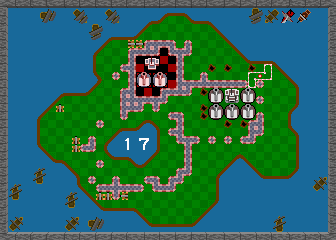
Castles available: 2
It all comes down to this. This level is a special kind of hell, only slightly mitigated by the fact that it seems you can get away with sinking fewer ships here, and, because you’re surrounded on all sides, your shots often don’t have that far to travel to reach a ship. There are four prime landing areas, each in one corner of the map, so landings can only be delayed, not prevented. And you only get two castles. Enjoy!
When you start looking more closely at the map, some slight advantages become apparent. There’s a lake in the bottom-left of the board, which gets in the way, somewhat, of grunts approaching from the bottom. Both castles have a good amount of land around them, although there are so many Red Ships here that the “summer home” strategy is essential to survival.
The continue limit eases up a little bit here. If you were at the maximum of four continues upon starting Level Six, the game will grant you an extra continue when you get here. (You still have to pay your coins for it though.) And also, if you were at that final credit, the game will actually downgrade your cannons one step when you get here, so get used to expending two/three/five shots for Gunships/Landers/Red Ships again. If (ha ha, “if”) you do expend that last continue, you go back to only needing one/two/four shots to sink ships. (There is more information on the effects of continues on cannon power in the notes, later on.)
This level is an ordeal, but it can be finished surprisingly quickly. I’ve seen it cleared in three rounds, although that was after several continues (it had been a pretty great game up to that point). This level is the big obstacle to one-credit clears, I’ve managed to finish everything up to it on one credit only to bang my head against it repeatedly. Using save states, I’ve managed to finish it with a single continue, so it is possible to finish it relatively cheaply, but making do with such weak cannons is a real challenge.
Arcade Mermaid: Rampart, Part 3: The Phases

Arcade Mermaid is our classic arcade weirdness and obscurity column! Frequently (no promises) we aim to bring you an interesting and odd arcade game to wonder at.
Because I’m out of town for a few days, we’re continuing our week-long coverage of Atari Games’ brilliant, yet really hard classic arcade strategy game Rampart.
Each of Rampart’s phases has its own considerations, so let’s take them one at a time.

Battle Phase
Rampart’s most traditional mode is its Battle sequence, which plays a bit like Atari’s old hit Missile Command. For a limited amount of time, players use the trackball to move a crosshairs around the screen, and the Fire button launches a cannonball from one of their cannons aimed at that spot.
Cannonballs have a set speed that they travel as they move through the air; nearby shots go directly towards the destination, but distant targets travel in a high arc. Thus, more distant shots take much more time to reach their targets, due to the fact that they have to be angled upward.
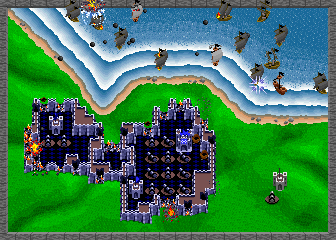
The speed of your shots matters for two important reasons. First, in single-player mode, enemy ships don’t always sit still and let your projectiles sink them, but move around at different speeds, and sometimes even try to dodge your shots. One of the most annoying events in Rampart is when you launch a volley towards a ship, and it decides to pull anchor and float elsewhere just as your shots launch, wasting those precious missiles. Firing at close-up ships means you don’t have to lead your targets by nearly as much, and reduces the chance that a ship will just sail out from under your projectiles.
The other important thing is, each cannon can only have one shot in the air at a time. Firing at nearby targets means you can get more shots off during a Battle phase. The combination of the two, being more accurate when shooting moving targets and getting more shots off, means that, absent other issues, you should prioritize firing at ships near your guns.
You cannot entirely erase the chance that a ship will decide to start, or stop, moving after you launch shots towards it, but there is some finesse that can be applied. Ships always sail in a straight line in one of the eight cardinal/diagonal directions, and ships cannot move through other ships. If a moving ship runs into another one, it will stop. They cannot turn around while in motion, but must wait until their invisible captain picks a new direction, which could be immediately or never. They also stop if they reach the shoreline, which for a Lander could be very bad for you. Once in a while a moving ship will just stop for no reason. The only constant is, all ships stop moving at the very end of the Battle phase, once all cannonballs have landed.
The rules of cannonfire, the ones concerning shot speed and there only being one shot in play at a time per weapon, they also apply to the enemy ships. Nearby ships are able to launch more shots at closer walls than distant ones, another reason to prioritize shooting nearby ships. But this must be balanced against those times when you need to prevent a landing, or take out some Red Ships to make the Build phase more survivable.
The game continues no matter how many ships you sink in Battle, but to progress to the next level, and eventually win the game, it’s advantageous to sink ships. The exact qualification for finishing a level is unknown, but it seems to happen after you wipe out most of the ships on-screen.
There is a maximum of 16 ships that can be in play at any time. If that number is reached, but there are some weakened or Single-Sailed Ships on-screen, Rampart is known to remove some of them so stronger ships may enter the fray.

Building Phase
This is the meat of the game. While shooting ships eventually clears levels, you can’t do that without cannons, and cannons are awarded from skill at building. Also, if you fail to capture at least one castle in a round, you lose.
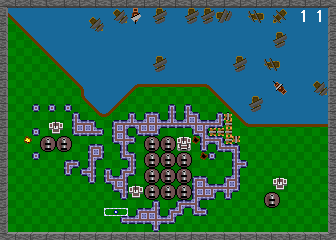
The way it works is, the game hands you an assortment of building pieces of various shapes, one at a time. The pieces you’re given first exist as just a flashing outline that you can maneuver freely over the land with the trackball or joystick. You can move it anywhere while you’re getting it into position, or rotate it clockwise with a press of the “Rotate” button. (If you start out your first building phase without using the button, the game’s voice will suddenly intone, “Use ROTATE for a better fit!” Rampart doesn’t have nearly as much digitized speech as Gauntlet, but it sure is memorable when it does speak.)
The difficult bit is, you cannot place pieces anywhere there is something per-existing. A piece cannot be placed if any part of it overlaps with another wall, the shore, a castle, a cannon, a crater, a grunt, or the edge of the screen. Everything visible beneath the piece’s outline must be the clean, green checkerboard of countryside.
You must place the current piece before you get the next one. Intermediate Rampart players ruefully observe that the game tends to hand out just the wrong piece they need at a given time. A lot of this is observation bias, you don’t tend to notice the times when the game hands you just the right piece, but it’s true that the pieces the game has to hand get larger and more complex as the game continues.
When a piece is plopped down it turns into wall. If the wall adjoins wall pieces already extant, they’ll join together pleasingly into a solid-looking structure. Your task is to connect wall pieces together like this until you have a complete loop all the way around and enclosing at least one castle. Usually you want this castle will be the one you start with, called your “Home Castle.” It’s worth extra points and cannons if you capture it, but any castle will allow you to survive.
There are two particular hassles in the Building phase that deserve special mention. The first are those grunts the Landers sometimes drop off if they reach the shore, and that have the power to move around during Building. They look like tiny tanks, or little battering rams.
Grunts move during Building, meaning they can actually block pieces just as you’re trying to place them. They not only move, but slowly multiply as they go, tending to form lines between the shore and your castles. Worst of all, grunts that make it to your castles have the power to destroy them during the following Battle phase, the only thing in the game that can harm a castle itself.
Grunts are so dangerous that landings must quickly be dealt with or else your game will soon be over. You can shoot them during the Battle phase, or you can surround the territory they’re on, destroying them instantly with a satisfying crunching noise.
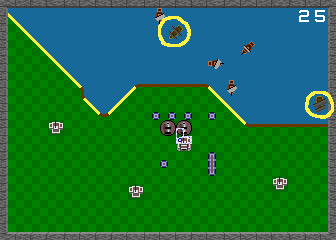
One important thing to note about grunts is that they can’t be dropped off just anywhere. Landers (here circled) can only leave grunts on diagonal shorelines. Highlighted above are the landing sites on the “Hat” map. Guard them at all costs.
The other problem you must worry about during Building is craters, flaming pits in the very ground left when the red cannonballs launched by Red Ships strike your wall. A crater is an implacable obstacle; there is no way to remove a crater from the board other than time. Near the end of the game, depending on the randomized ship generation, you may end up with rounds where you must face six or more Red Ships at once, which is horrifying.

When a crater is formed, it’s a full-strength pit of fire. Every Battle phase, each crater diminishes a bit. They all do this in lockstep: all the craters formed in one round will advance to the next state at once.
How does the game decide how quickly to make craters disappear? It’s a function of how recently you’ve put in money and continued the game! If you’ve recently continued, then for a while the game makes craters disappear in two rounds instead of three.

Cannon Phase
The Cannon phase is much less tense than the others. You get ten seconds to place additional cannons for subsequent Battles. But placement of cannons is one of the most important decisions of all. In a sense, the reason you’re capturing castles, beyond mere survival, is to support your artillery.
For the first Cannon phase of the whole game, the game gives you three cannons to get you started. On the first Cannon phase after continuing, you get four, as part of the “and more firepower” the game promises. On the first round of other levels, you start with just two.
Beyond that, on each successive Cannon phase, you get two more cannons to place for having captured your home castle, and one more for each other castle. But this only happens if you have room to place them. When surrounding castles in the Building phase, you must not only survive, but try to leave extra room for placing cannons, that is, if you want more artillery.
The more cannons you have, the more shots you can get off in the Battle phase, and thus the more of a dent you can put into the enemy navy and/or other players’ walls. This, in turn, decreases the shots coming in towards your walls, lets you do something about Landers before they drop off Grunts, lets you shoot at Grunts directly, allows you to sink more Red Ships before they set your whole countryside ablaze, and ultimately depletes the opposing navy faster.
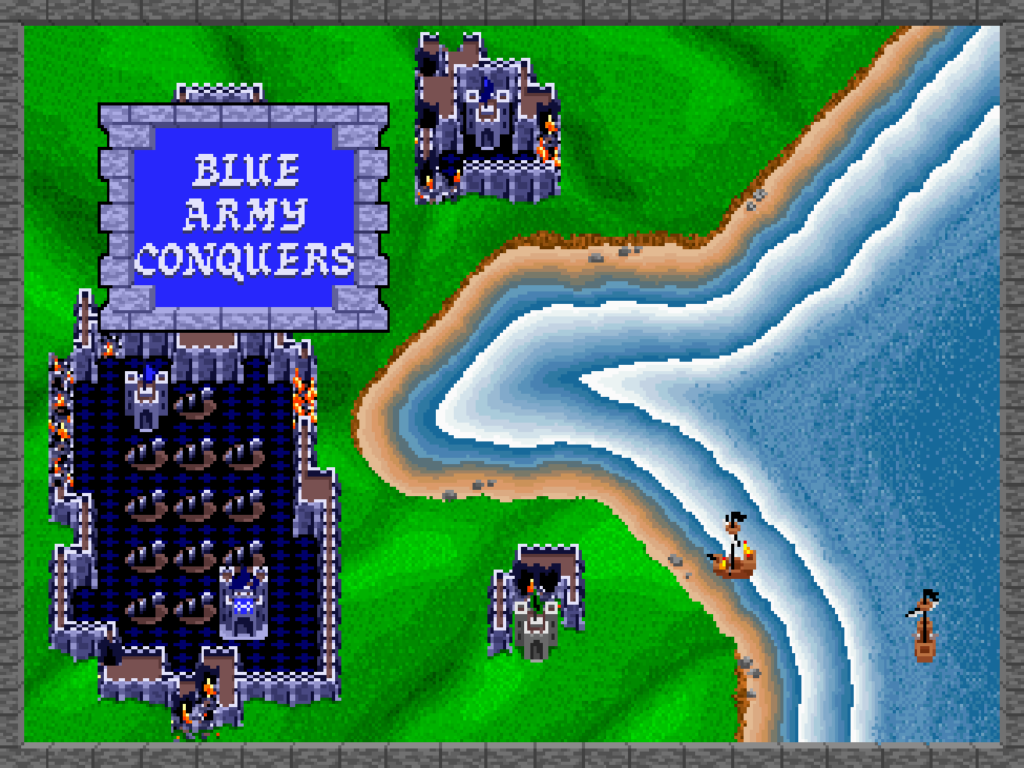
Lots of cannons mean lots of shots! Shots can stop landings, clear out Red Ships, and hasten the end of the level.
But cannons are also a big problem. Each cannon you place is a 2×2 square of ground that cannot be otherwise built upon, which restricts the shapes of pieces that can fit on the ground. Having lots of cannons progresses you through the level, but increases the area you have to surround to survive.
Practically, you must build at least some cannons directly adjacent to your castle, and other cannons adjacent to those, in a big sulfuric blob. Thus, to capture that castle, you’ll also have to capture all the cannons that adjoin it, a mass of guns that grows in size with each round. And in case you come up with the idea to build cannons away from castles to avoid this, you should know that cannons that aren’t “owned” during a battle phase sit idle, doing nothing.
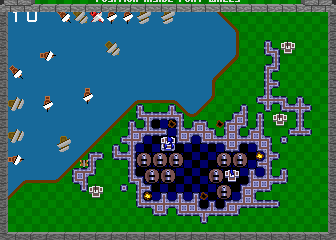
A “summer home” is a secondary castle you turn to in order to survive, usually with cannons attached, when your home castle is too difficult to recover.
You must have cannons to survive through each level, to punch back against the enemy, to take care of threats and eventually to advance towards finishing it, but having them makes later Building phases harder. Once a cannon is placed, it cannot be removed except by losing and continuing the game. And not having any cannons is a counter to using the “summer home” strategy for every round: while you can often abandon your home castle and its armaments in favor of a small unadorned dwelling out in the sticks, unless you’ve built cannons there on previous rounds, you’ll have, at most, one gun to thwart landings. A lot of games have ended due to this.
One subtle aspect to Rampart strategy is the cannon firing order. Cannons fire in the order in which they were placed. Any uncaptured cannons, and also cannons with shots in the air, are ignored in the queue. The difference in lead time between a cannon near the shore, and one way back at the screen edge, is significant, and can result in a lot of missed shots. To thwart this, it helps to try to build cannons in one mass, instead of spread out, and to try to build in more centralized locations, but truthfully it’s difficult to consciously make use of this strategy during a game.
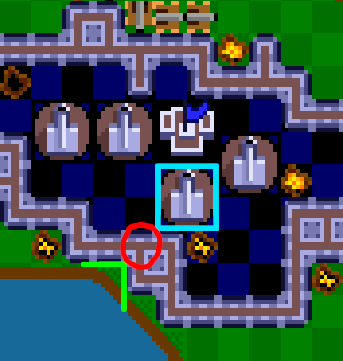
This is a danger spot, a location where, if a single Red Cannonball hits, it renders the whole castle and its cannons impossible to capture.
One thing that players cannot afford to ignore is the danger of building cannons too close to the water or the edge of the screen. This is a huge concern. Building cannons close to hard barriers like those greatly reduces the number of pieces that will fit between the gun and the obstacle, and increases the chance that a red cannonball will hit in a such a place as to create an impossible rescue. To the game’s credit, Red Ships do not appear to target these locations intentionally, but neither do they avoid them, so It’s important to try to leave at least two spaces between cannons and any hard barriers, and more if you can. Especially look out for one-space diagonal separation, because it isn’t as obviously dangerous as horizontal or vertical. The more free space around your installations, the easier it’ll be to build walls there later, and the better off you’ll be.
So what if you decide you have enough cannons and don’t want to place some or all this round, do you have to sit and wait out the clock? Why, no: if you make five consecutive illegal cannon placements in a row, the game will take that as a signal that you’re done placing them and end the Cannon phase immediately.
That’s three parts so far! Yes, there’s more to say about this diabolical game, but we’ll take a break for a couple of days, for other posts. See you soon!
Sundry Sunday: Proving Grounds of the Bard Fox

Sundry Sunday is our weekly feature of fun gaming culture finds and videos, from across the years and even decades.
Taking a short break form gushing over Atari Games’ Rampart to bring you this fun, short animation, by Only Jerry, set to the battle theme of the Japan-only PC Engine version of Wizardry. It’s only a minute or so, so please enjoy!
Grey: A FPS on a Commodore 64
Grey is what the subject line says: a FPS, running at an acceptable framerate, on a Commodore 64, without a Raspberry Pi or other hardware to help it out. Here is its thread on Lemon64. Have a look (24 minutes):
How is it possible? Well, it’s not running 60fps for one. Updating the whole screen in one frame on a C64 is hugely challenging, but fortunately FPSes can look satisfactory running at slower framerates. It’s not Quake-level graphics, or even Doom, it’s more like Wolfenstein 3D in ability, and it’s confirmed that it uses that style of raycasting. And on top of all of that, it doesn’t use hi-res resolution, which would be really slow on an unmodified C64. It seems to use character tiles to fake a kind of low-res display. But when you’re trying to get a game running on a 1 MHz machine with 64K of RAM, tricks and shortcuts are not only necessary, but rather laudable. What a hack!
This is a work-in-progress, with a demo of the game available in a recent Pateron-available issue of Zzap 64. No source code is available yet. Let’s hope for continued development!
Arcade Mermaid: Rampart, Part 2: Overview

Arcade Mermaid is our classic arcade weirdness and obscurity column! Frequently (no promises) we aim to bring you an interesting and odd arcade game to wonder at.
We continue our lengthy, obsessive coverage of Atari Games’ brilliant, but really difficult, arcade strategy game Rampart.
Overview
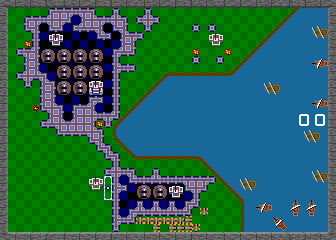
Rampart is really two separate but related games, the single-player game and multiplayer. Both are excellent. Even so, this article mostly concerns itself with single-player, but towards the end I will have a few things to say about its multiplayer mode.
Before we begin, you should know that Rampart is a highly abstract game, and as such it might not be easy to see how it all fits together from a text description. I have uploaded several complete playthroughs of the game to YouTube, the first such on that site of the arcade version. You might watch a bit of one of them, it should make it pretty obvious how the game works.
The Board
In both single-player and multiplayer, after selecting a home castle and placing initial cannons, the game repeats a sequence of rounds, each consisting of a Battle phase, Building phase and Cannon phase. In the Battle phase, players shoot at ships or the other players’ walls, while those ships or enemy cannons fire back at their own walls. In the Building phase, players place a variety of shaped pieces in an attempt to fix their wall and/or construct walls around at least one of the castles on their land within a time limit. Then in the Cannon phase, players get a number of new cannons to place within the territory they captured in the Building phase, adding to the number of shots they can get off in Battle.
Select Home Castle, then
Cannons -> Battle -> Building -> repeat
This cycle continues until the player wins or loses. Losing happens when a player fails to capture a castle in time in Building. Winning happens, in single-player, when the game decides the ships don’t have a reasonable chance of defeating the player, and advances to the next level, out of six in total. In multiplayer, it happens when all the other players have lost and don’t continue, or for a set number of battles. If the fight goes the full distance, the winner is the surviving player with the highest score.
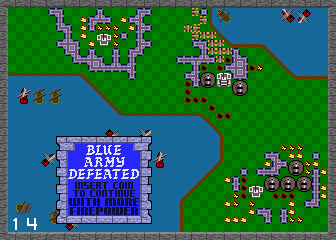
A defeated player can put more money in the machine to continue the game “with more firepower.” This is allowed four times in single-player, so up to five credits in all, and losing after that results in a solid Game Over. The dynamics of continuing in Rampart are really more complex than this, and I’ll explain those later, but for the time being, you should know “with more firepower” signifies several important changes that are not all clear during play.
In multiplayer, losing players can choose to continue individually twice. That can make for a decently long game if all the players choose to buy all their continues. But eventually, the game will declare a round to be the “Final Battle,” after which no continues will be offered to losing players, and the game ends regardless. The number of rounds a game is allowed to go is operator-adjustable, and continued games usually add a few battles to the overall length.
There also exists one semi-secret game variation. If just two players play Rampart, and at least one of them is joining in again after a completed game, there is a map selection screen that offers the chance to play a composite game mode, featuring both two players and ships! In this, the ships belong to one or the other side, and are color-coded based on who they belong to. They function like extra cannons, generally firing where the player aims their cursor, but are more autonomous. This mode is an interesting variation, and is fairly obscure. Could there be other such secrets hidden in Rampart’s code?
Basics
For now, we’re most concerned with figuring out and defeating the very difficult single-player game. The basic play of both games is similar, but there is a lot of difference between attacking ships or walls, and the structure of single-player is quite different, so it’s worth treating each mode separately.
When you put a coin in and press Start, this appears:
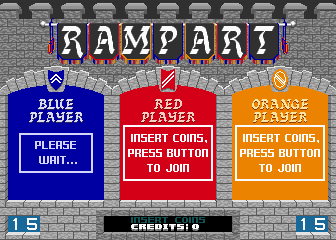
This ornate lobby screen is accompanied by booming drums and realistic, although synthesized, trumpets and fifes. With the volume turned up (as all Rampart machines should rightfully have) the effect is startling and bound to attract some attention. The purpose of this screen is to give other players the opportunity to join the game, for unlike the Gauntlet-style, “join any time” play model Atari pioneered and most arcade games used, once underway a game of Rampart cannot be entered by others. Players can only leave a game, by failing and not continuing.
An interesting thing about Rampart is that, after a game concludes, it always returns to the lobby screen and adds the player’s score to a total across all their games in the session. This encourages players to play repeated games, to see their overall score climb higher and higher. I’ve seen the total go up to over 900,000 points, which takes around 18 full-length games. I know of no reason to go for a high total score other than vanity, but if someone else has information on this I’d certainly like to know!
Your Domain
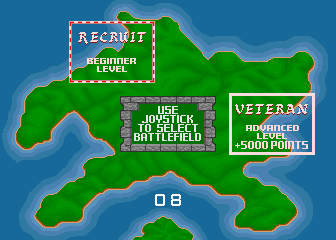
Assuming a single-player game, the screen clears and shows an overview screen of an island. There are four possible maps that can be selected for play here. At the start of the game, two areas along the shore are boxed, one marked “RECRUIT,” the other “VETERAN +5000 points.” Most of Atari Games’ arcade releases had such a selection, for it was a major part of their house style to offer a basic and an advanced difficulty, with a score bonus for starting harder. With Rampart, this choice is mostly an illusion. All choosing Recruit does is start you off with a very easy first board (the Recruit map is always the “J” map), which usually takes two rounds to finish.
Each level pits the player against a larger and more dangerous enemy navy.

At first, only weak Single-Sailed Ships attack, which go down with two hits from basic cannonry. Here, I call these Gunships.

With level two comes Double-Sailed Ships, a.k.a. Landers, which take three hits, and if they manage to get close to a diagonal shoreline, they drop off a swarm of evil little Grunts.

Grunts are a huge danger! They are the only enemy that has the power to move around during the Building phase. I’ll have more to say about them later, but for now just know that a grunt beachhead, left unopposed, has more credit-ending power than anything else in the game.

Starting with level three, Red Ships join the battle. Although few in number at first, these take five shots to sink, and their red cannonballs leave fiery craters where they land. Craters block piece placement and persist for multiple rounds. Usually a Red Ship can get off two or three shots each Battle, and they add up.
Levels four through six feature the same kinds of ships, but they’re darker in color, which in game terms means they take one additional hit before sinking. Dark Gunships take three hits, Dark Landers require four hits, and Dark Red Ships only go down after six cannonballs have struck them.
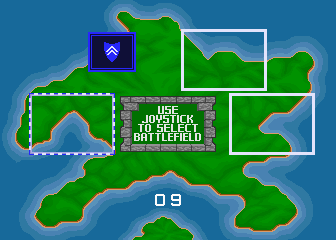
Every time you complete a level, you’re returned to the island screen to pick a new map to play. After the first level, three remaining unplayed options are offered. If you chose a Recruit game you’ll eventually have to face all these boards, but if you picked Veteran and started on level two, you end up skipping one of them, an opportunity to avoid a disliked map.

The “C” Map
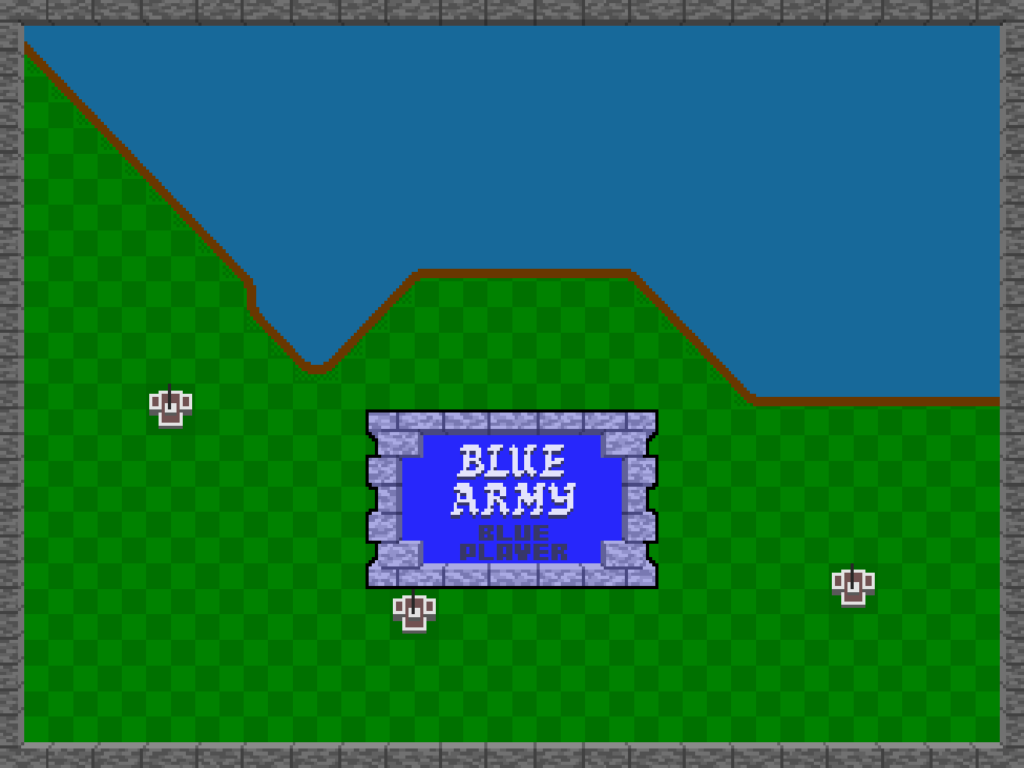
The “Hat” Map
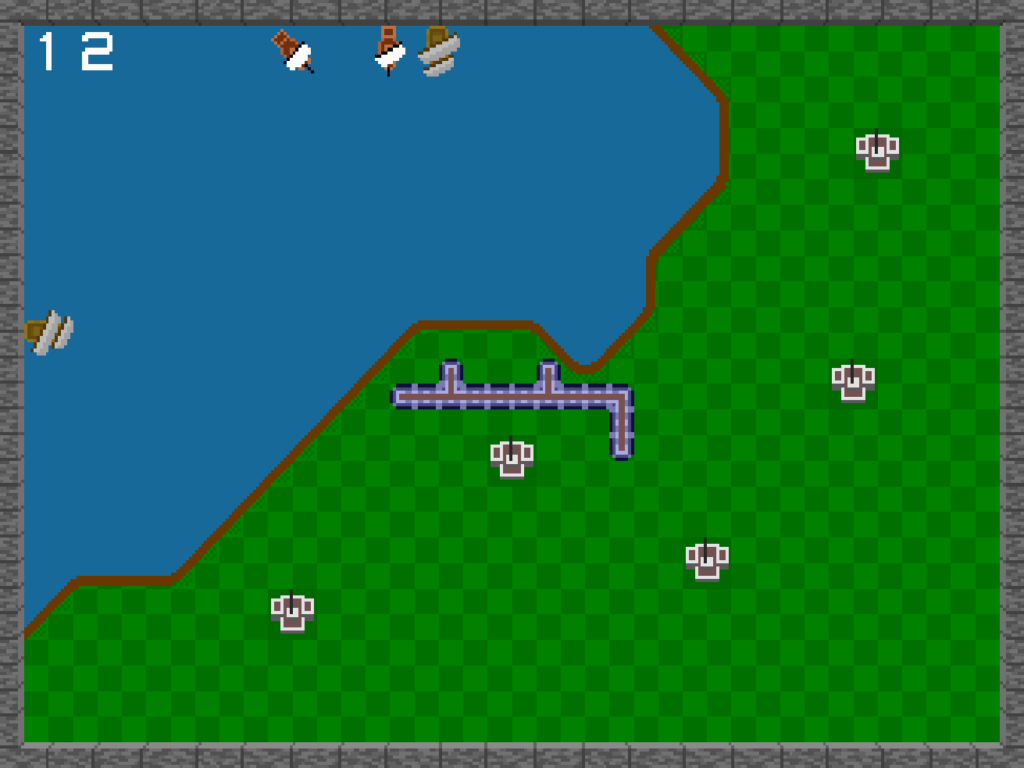
The “J” Map
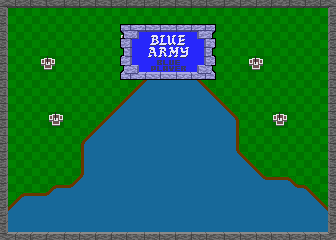
The “N” Map
The maps are not even in difficulty. Generally, easier maps have castles with land around them on all sides, and more straight horizontal or vertical coastline, giving Landers fewer places to land. My opinion is that the “Hat” map is the easiest, followed by the “J” map, then the “C” and “Lowercase N” maps. A good strategy is to try to get one of the harder two maps out of the way as first selection, so you can later play the J and Hat maps to offset the harshness of the third and fourth levels, but sometimes the Veteran selection level ends up being the Hat, and you’ll have to play them in a different order.
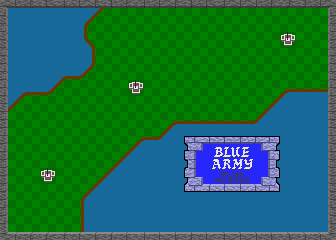
The “Slash” Map

The “Backslash” Map
Level five is selected from one of two unique maps, both peninsulas with water on both sides. Both are difficult, although I think the “Backslash” board is a little easier. As you progress, each level starts you out with fewer castles to capture. By this point you’re only getting three castles, and you’ll probably have to use all of them to survive.
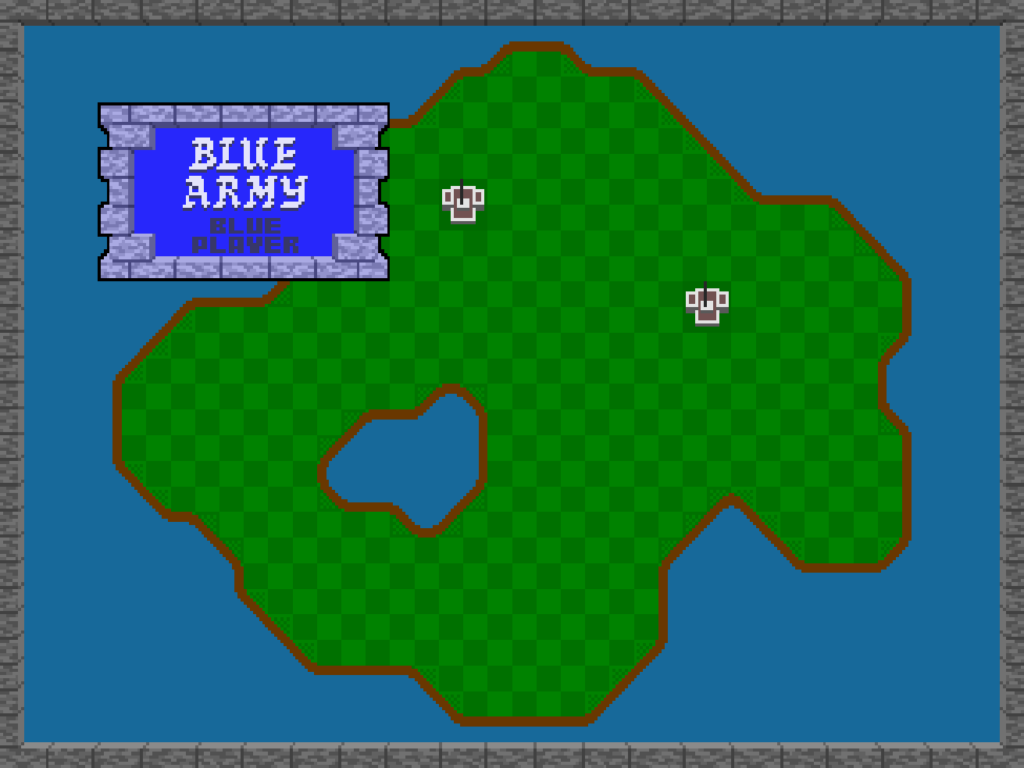
The final, “Island” Map
The last level is an island to itself, with a lake on it and only two castles! Here, ships attack from both sides of the screen. This level is a trial; although you have to sink fewer ships here to win, it’s difficult to prevent landings and grunts from overwhelming you, and the craters from Red Ships can easily give you an inescapable situation unless you mitigate them.
If you finish the last level, you get special ending music, and an illustration that few arcade goers have seen, before being returned to the High Score and Lobby screens. It may seem anti-climatic, but final victory and safe shores are their own reward.
Arcade Mermaid: Rampart, Part 1: Introduction

Arcade Mermaid is our classic arcade weirdness and obscurity column! Frequently (no promises) we aim to bring you an interesting and odd arcade game to wonder at.
The next week is going to be pretty busy for me, so I’m reusing a long long piece I originally wrote for the short-lived fanzine I made, Extended Play. It’s been seen before, but only by a very small audience.
Rampart has been an obsession to me since it came out around 1990. I still think it’s one of the finest arcade games ever made, actually one of the best video games period. People tend to describe it as either an early version of Tower Defense, or Missile Command meets Tetris, but neither description is very good. Simply, there had never been a game like Rampart before, and despite some attempts to clone it, there’s never been a game like it since, either.
We’re all as obsessed with weird old arcade games as I am, right? Right?? Most (but not all) of the next week of posts will all be about this wonderful, but extremely difficult, game, one of the best from Atari Games at their heights. Please bear with me, and please, try to understand why I’ve been so into this unique game for so long.
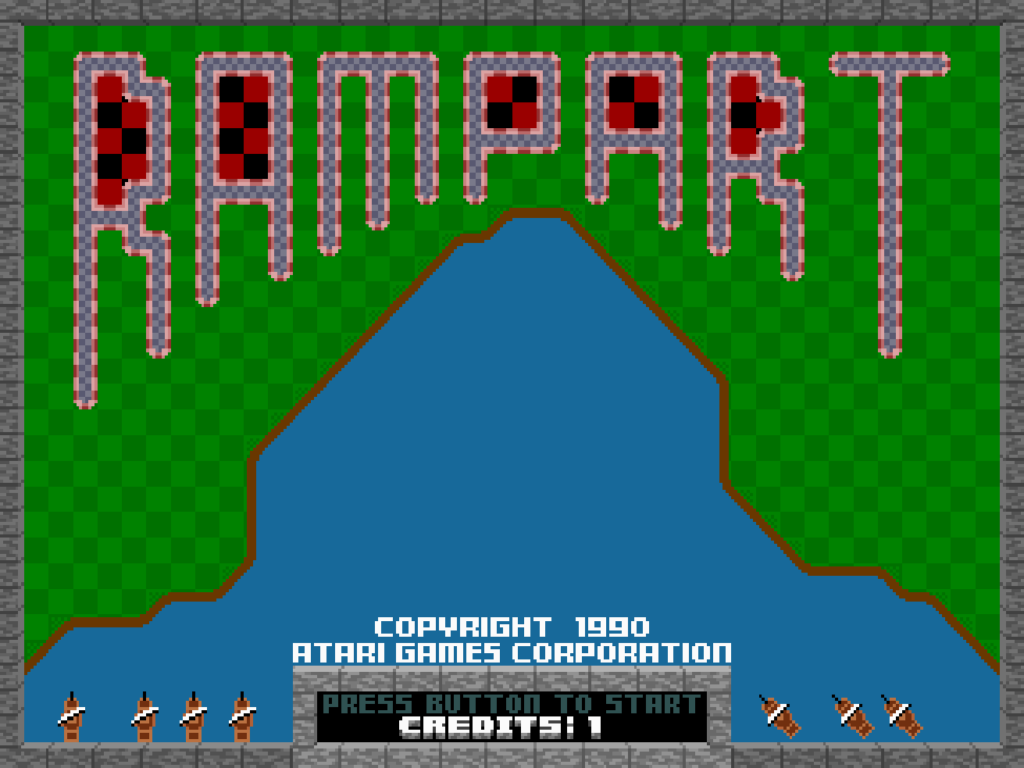
In the late 80s Atari Games was recovering from 1983’s Great Game Crash, which decimated the US arcade industry and resulted in a great dying out of companies. Atari Games, newly split away from the consumer electronics company that would make the Atari ST, weathered it better than most, primarily through developing ingenious kinds of games the likes of which were seen nowhere else.
This period, 1984-1990, is the age that began with Marble Madness and the System 1 hardware, followed by hits like Paperboy, 720 Degrees, Gauntlet, Toobin’, Cyberball and others. It lasted roughly to the release of Street Fighter II, which sparked the fighting game craze and made arcades inhospitable to most other genres for a while. At the tail end of this period came Rampart, designed by John Salwitz and Dave Ralston, who also created three of the games in the foregoing list.
It’s a bit obscure now, but it was quite a hit for Atari at the time. For home systems Rampart received no less than thirteen distinct ports, plus a few notable emulations. It got very good reviews from Nintendo Power (SNES version) and Videogames & Computer Entertainment (arcade). More recently, it was released emulated with network play for free for the PlayStation 3. And yet, still, no one talks about Rampart anymore.
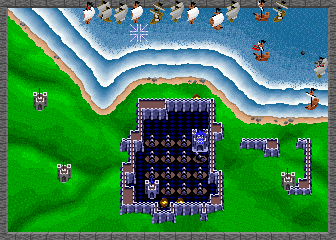
That is a weird thing about what I call Atari Games’ “Silver Age,” that time after the classic arcade boom of the late 70s/early 80s but before the rise of one-on-one fighting games, its games, while still fun and surprisingly ingenious, and widely ported, don’t have the star power, other than a couple of things like Gauntlet, that Japanese releases from the same time have garnered.
Part of the reason may be trademark-related. The name Atari still carries considerable nostalgic weight, but another company, the one formerly known as Infogrammes, bought the trademark and the classic Fuji logo, and still releases games under it. They own the rights to everything before Marble Madness. Games after that were owned by Midway for a while, but Midway then, in a crushing indignity, renamed them Midway Games West, before closing them outright in 2005, getting out of arcades altogether. Many of its assets were sold to Warner Bros. Entertainment, who presumably now owns the rights to Atari’s post-Marble Madness catalog.
I’ve written before that, at their peak, I think Atari Games was more ingenious and original than Nintendo themselves. They made some stinkers, sure (few remember Thunderjaws, or their arcade take on Tim Burton’s Batman movie) but their best games were, and still are, amazing. I think that Rampart, while little talked about now, is at the top of the gilded heap.
Rampart is great, but it’s difficult. For a game I’ve been obsessed with since its release in arcades in 1989, I can only complete it on default settings about a third of the time, and usually only after expending all the continues the game allows. This was common for Atari Games games, who tended to make arcade machines that mocked the idea of one credit runs, but even among those, Rampart is hard. You are not going to master this one overnight.
I view my purpose here usually to be a secondary source. That is, I prefer to summarize, encapsulate, explain and preserve information available elsewhere. But the thing about Rampart is, there is very little of this information to find. For a game that was popular at the time of its release and with so many ports, googling it will not turn up much to aid you. As far as I know, and I’ve searched for it many times throughout the years, Rampart has never had a good, comprehensive strategy guide written for it.
It is because of this, favored reader, that I have decided that this shall be that guide. Since most of it is self-discovered, I have no one to blame for errors but myself. I have made some efforts to make sure it’s correct, but, well, sometimes even well-considered assumptions turn out to be false. I’ve done what I can.
(More tomorrow!)
Sunsoft Hebereke Cartoons
Hebereke is that NES game, released in European territories as Ufouria, with the cute, yet somewhat bizarre, characters. It recently got a Switch release (“Enjoy edition”), and kind of a sequel.
Sunsoft has released some animations of Hebe and his friends on their Youtube channel. Each is very short, and entirely in Japanese, but most of them don’t have words anyway, and they’re all of a style of humor that I don’t think they make a huge amount of sense even in their native language.
They’re all collected in this playlist, but a couple of selections should help you understand what you’re in for. All of these are about one minute long.
Hebe buys a toy gun:
Hebe and Sukezaemon race on what I’m going to call jet-powered “vehicles”:
And, trouble with bird poop:
Legends of Wario
There’s this image going around, referred to in this video as a “greentext” image, in that way that people who are very online will just throw out there and expect that everyone knows what they’re talking about when other people (like myself) who are at least as online don’t know because they weren’t online in the same way. It seems that a “greentext” image is that way because it’s a quote in an old 4chan thread. Bleh.
But anyway. Said image is a list of obscure, but apparently canonical, facts about everyone’s favorite money-grubbing antiplumber, Wario. Narrator Mish Koz goes through each fact and tries to determine from whence it came. Many of them are sourced from an old Nintendo website. They’re entertaining at least, for 17 minutes. Here is the video:
The facts are:
- He has a bee allergy
- He likes wrestling & country music
- His favorite foods
- He can bench press 200 kg
- Dr Crygor uses him as a guinea pig for his experiments
- He goes treasure hunting with Mona
- He gave 9-Volt a GBA
- The reason for his immortality is he doesn’t feel like dying
- Things Wario hates: smart things, jerks that are stingy with their money, chocolate with peanuts, marron glacés, peppers and jigsaw puzzles
- Wario’s spending habits: he spends most of it on food
- He ate 100 Poison Mushrooms and red and white spots appeared over his body
- He washes his clothes every 10 days
- The source of his powers: garlic
- He has a farming background, although no one seems to actually know the source for this fact
Investigating the Wario Greentext (Youtube, 17 minutes)
/dev/scream
Computer entertainment is a wide field, and it’s easy to forget that it’s not all jut vidja gmaes. Por ejemplo.
On Linux machines, there is a system “device” called /dev/zero. If you pipe its cont ents into something else, like a file, it provides an endless stream of zero bits.
Someone, going off of that idea, created another virtual device called /dev/one. It produces an endless sequence of 1 bits. Usually this takes the form of 255 bytes, which are binary 11111111.
/dev/zero is more useful than /dev/one, since zero bits also make zero bytes. Usually, if you’re using /dev/zero, you don’t actually care much about the data you get anyway. /dev/one is mostly for the entertainment of a weird sort of Linux user, presumably one that makes jokes about vi and Emacs.
Well to that kind of person, /dev/scream should be 20% more entertaining still. (A 20% increase should rightfully, I think, be called a “Dash.”) It produces an endless randomized sequence of two characters, capital and lowercase A, and capital and lowercase H. So:
“AHAhaHaAAHHahaaAhAhHAHaAhAAHHhah”
The fact that it could be interpreted as either a sequence of screaming, or a sequence of laughing, could be taken as either a bug or a feature.
/dev/scream (GitHub)
